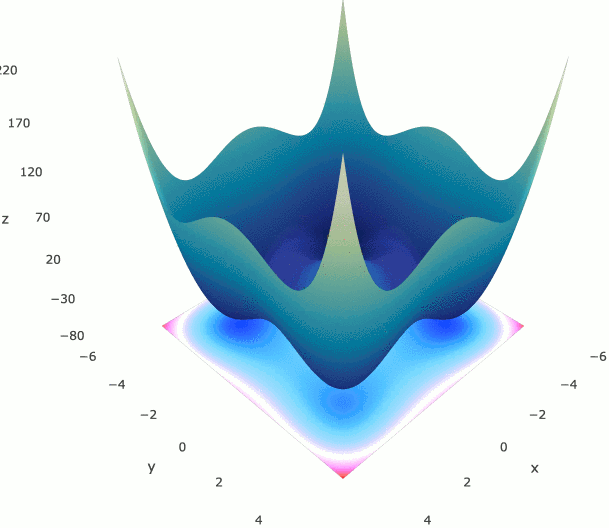Minimal Example: Styblinski-Tang¶
In the quickstart guide, we went over the three main pieces we need to get up and running with HyperSpace. That gave us a general idea of how the library can be used for machine learning models, but it didn’t give us something we can run right out of the box. So this time, let’s take a look at a complete, minimal example.
For this, we are going to make use of the Styblinski-Tang function, a commonly used benchmark objective function for optimization methods. The Styblinski-Tang function is usually evaluated on the hypercube \(x_{i} \in [-5., 5.]\) for all \(i = 1, 2, \dots, D\) in \(D\) dimensions. It’s global minimum \(f(x^{*}) = -39.16599 * D\) which can be found at \(x^{*} = (-2.903534, \dots, -2.903534)\). We are going to use the two dimensional form of the function, which looks like this:

In its two dimensional form, the Styblinski-Tang function has three local minima in addition to its global minimum. Let’s see if we can find the global minimum. The following example example contains everything we need to run the optimization. There are several benchmark functions built into HyperSpace in addition to the Styblinski-Tang function. I would encourage you to try out several of the functions, changing their number of search dimensions. This will give you a sense for how HyperSpace, indeed any optimization library, behaves in various dimensions. Without further ado, let’s do this:
import argparse
import numpy as np
from hyperspace import hyperdrive
from hyperspace.benchmarks import StyblinskiTang
def main():
parser = argparse.ArgumentParser(description='Styblinski-Tang Benchmark')
parser.add_argument('--ndims', type=int, default=2, help='Dimension of Styblinski-Tang')
parser.add_argument('--results', type=str, help='Path to save the results.')
args = parser.parse_args()
stybtang = StyblinskiTange(args.ndims)
bounds = np.tile((-5., 5.), (args.ndims, 1))
hyperdrive(objective=stybtang,
hyperparameters=bounds,
results_path=args.results,
checkpoints_path=args.results,
model="GP",
n_iterations=50,
verbose=True,
random_state=0)
if __name__=='__main__':
main()
Keeping in step with the quickstart guide, we have defined an objective function, stbtang. As we mentioned above, this function is typically evaluated on the interval \(x_{i} = [-5., 5.] \in D\), and so is initialized to that by default by HyperSpace. We then define our search bounds using Numpy’s tile function, which is a convenient way of creating an ndims dimensional array of tuples, each of the bounds from [-5., 5]. Then all we need to do is call HyperSpace’s hyperdrive function, telling it where to save the results (args.results).
Just remmber, HyperSpace initializes \(2^{D}\) optimizations in parallel. Therefore, if if we save this as a module called styblinskitang.py, we can run this example use the following:
mpirun -n 4 python3 styblinskitang.py --ndims 2 --results </path/to/save/results>
Try experimenting with the dimension of the function. This can be done simply by changing the args.ndims argument and adjusting the number of MPI ranks according to the \(2^{D}\) rule. Happy optimizing!